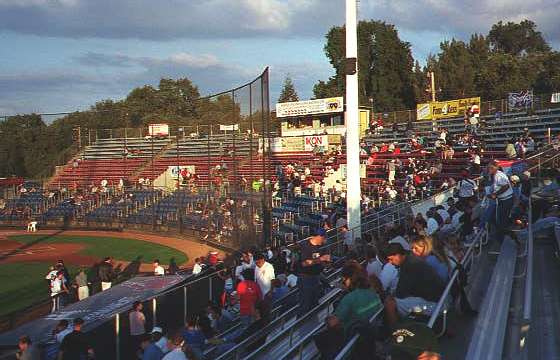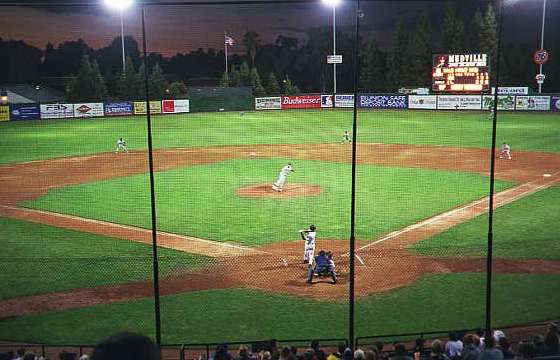 Interior of Billy Hebert Field, Sep-2000. |
 Looking out at the ballpark from behind home plate just after sunset. |
 Interior of Billy Hebert Field, Sep-2000. |
 Looking out at the ballpark from behind home plate just after sunset. |
 Chronological Tour: Stop 193 Chronological Tour: Stop 193 |

 2 baseballs
2 baseballs
The trouble with Hebert Field is that there’s absolutely nothing classic about it. The “stadium” is a roofless concrete structure behind the plate, with stadium box seats below the concourse and aluminum benches above, flanked by aluminum bleachers on both ends. The press box is only big enough for the official scorer, scoreboard operator, public address announcer, and home radio. The visiting radio announcer had to sit in “press row”, an area in front of the press box where the stands had been removed and tables and chairs had been set up on a wooden platform. And the clubhouse is through a gate in left field. When I attended a game over Labor Day weekend in 2000, the post-game fireworks couldn’t start until the players had all retreated to the safety of the clubhouse.
The ownership groups in Visalia and Stockton swapped clubs and facilities for the 2002 season, and the new occupants of Hebert Field reinstated the venerable Stockton Ports name. John Katz, of the ball club, advised in late March 2002 that the Ports had undertaken a major renovation project at the park as well. And finally, for the 2005 season, the Ports moved into a new facility, Banner Island Ballpark.
Billy Hebert, the field’s namesake, played for the Oakland Oaks in the Pacific Coast League. He was killed at Guadalcanal during the second World War, the first professional ballplayer to lose his life in that war. The field at Oak Park was dedicated to him in 1951.
| Game | Date | League | Level | Result |
|---|---|---|---|---|
| 437 | Sat 2-Sep-2000 | California | A+ | STOCKTON 7, Visalia 3 |